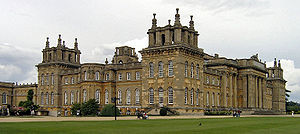Template:FP-Blenheim Palace: Difference between revisions
Jump to navigation
Jump to search
mNo edit summary |
No edit summary |
||
| Line 6: | Line 6: | ||
Blenheim was built between 1705 and 1722, intended to be a reward to John Churchill, 1st Duke of Marlborough, from a grateful nation for the duke's military triumphs against the French and Bavarians during the War of the Spanish Succession, most decisively at the Battle of Blenheim, and as a triumphal monument it was built in a grandiose style. | Blenheim was built between 1705 and 1722, intended to be a reward to John Churchill, 1st Duke of Marlborough, from a grateful nation for the duke's military triumphs against the French and Bavarians during the War of the Spanish Succession, most decisively at the Battle of Blenheim, and as a triumphal monument it was built in a grandiose style. | ||
Blenheim Palace was designated a UNESCO World Heritage Site in 1987.}}<noinclude> | Blenheim Palace was designated a UNESCO World Heritage Site in 1987.}}<noinclude>{{FP data}} | ||
Latest revision as of 19:01, 5 May 2021
 |
Blenheim PalaceBlenheim Palace is a monumental country house standing outside in Woodstock in Oxfordshire. It is the principal residence of the Dukes of Marlborough and one of Britain's largest houses. Blenheim was built between 1705 and 1722, intended to be a reward to John Churchill, 1st Duke of Marlborough, from a grateful nation for the duke's military triumphs against the French and Bavarians during the War of the Spanish Succession, most decisively at the Battle of Blenheim, and as a triumphal monument it was built in a grandiose style. Blenheim Palace was designated a UNESCO World Heritage Site in 1987. (Read more) |